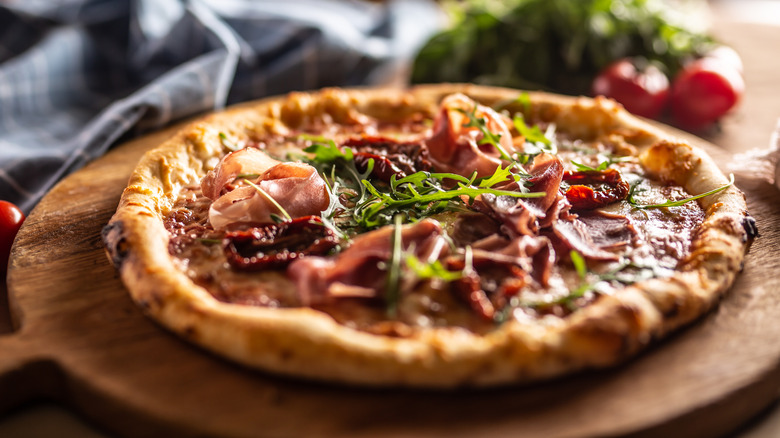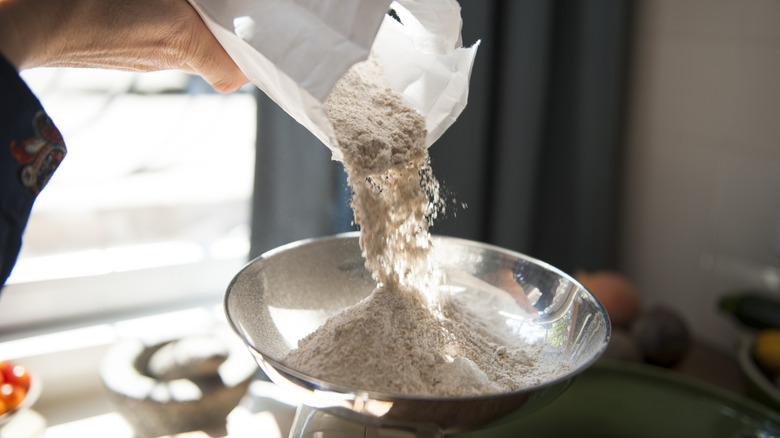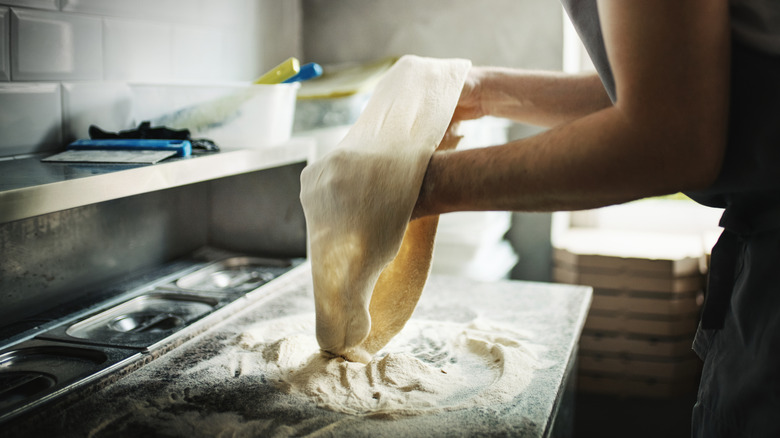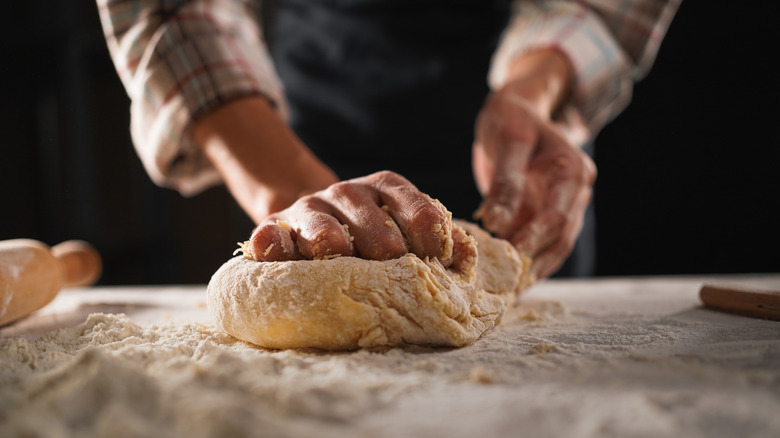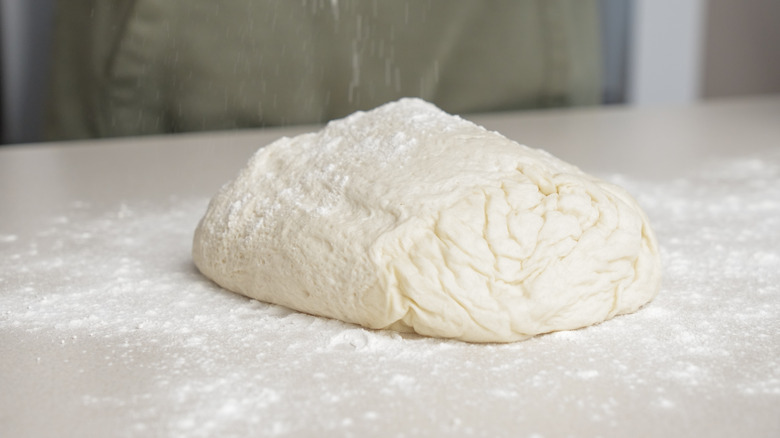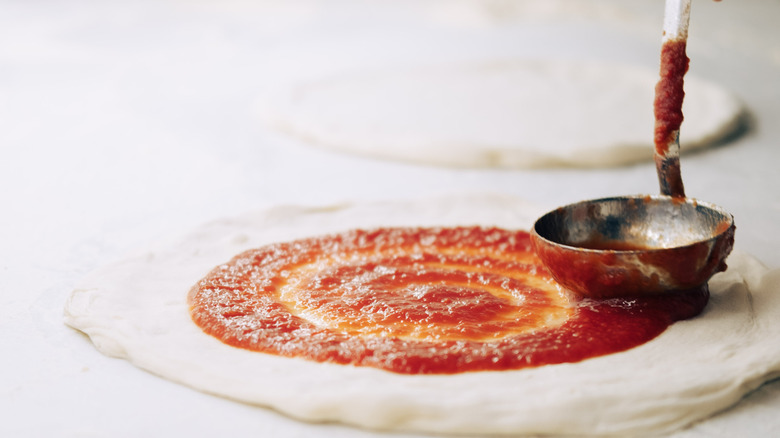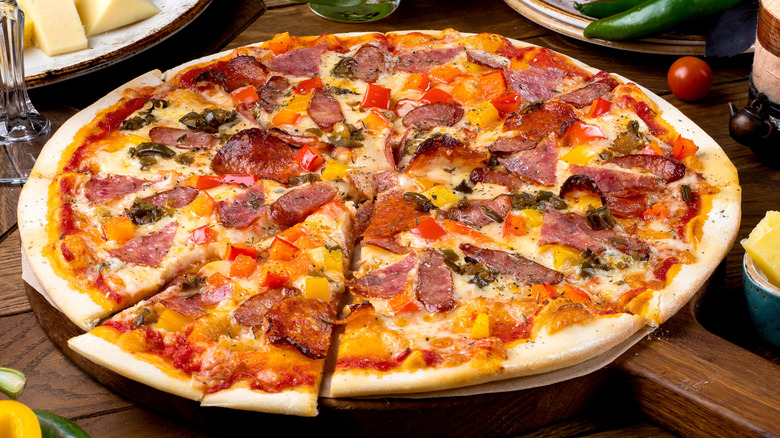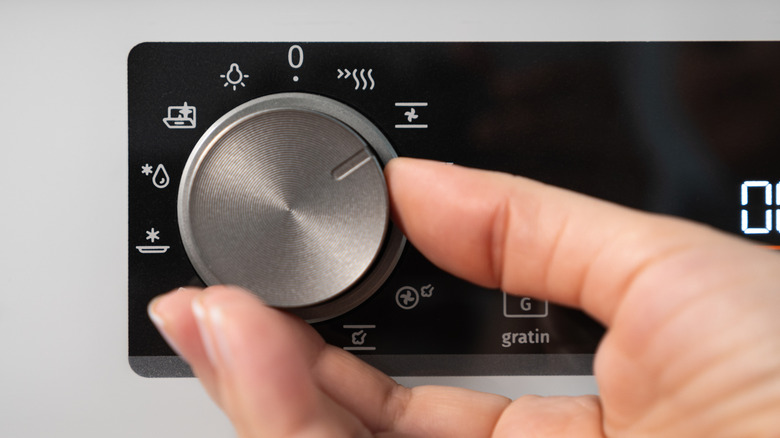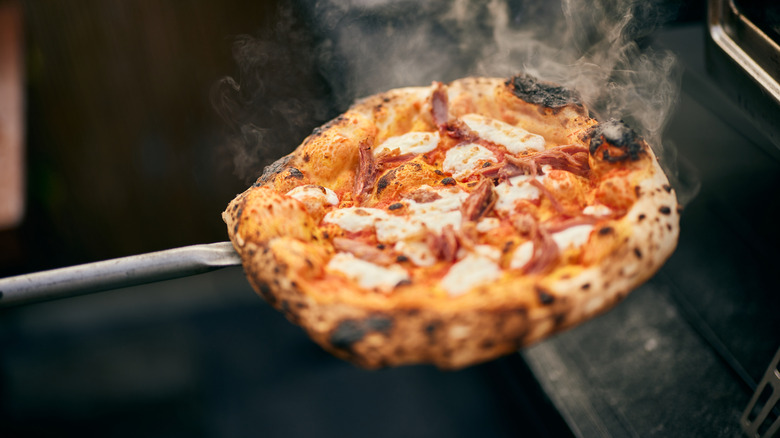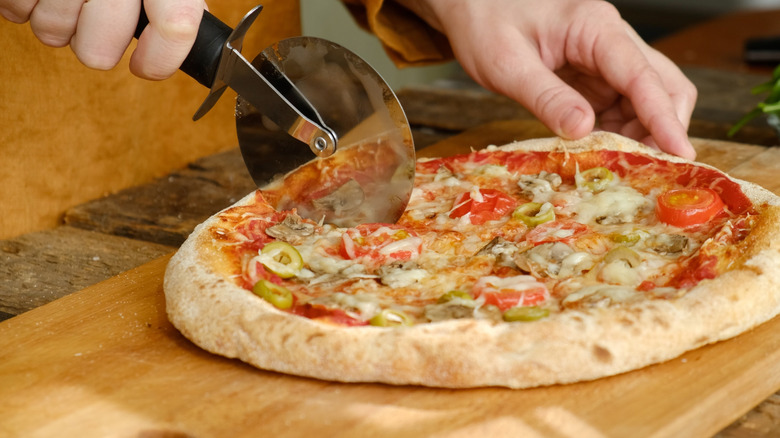10 Homemade Pizza Mistakes You're Probably Making, According To An Expert
There's nothing quite like pizza night. While some people prefer to order out, others choose grocery store frozen pizzas as a quick and affordable substitute. These ideas are great when you don't have a lot of time, but the best pizzas are homemade. Of course, whether you've made one or a handful of pizzas at home, you're probably making a few mistakes that keep your homemade pizzas from tasting on par with restaurant pizzas.
During my time in the food industry, I spent one year working the pizza station at one of the eateries I worked at. It was at this time I discovered the joys of making homemade pizza and began to craft them at home for my family from scratch — since then, I've tackled several dozen pizza nights. It was a learning curve in the beginning, but now, many years later, my homemade pizzas always come out fantastic. And yours can, too!
Today I'm going to share with you ten homemade pizza mistakes you're probably making, and offer my expert advice on how to rectify them. Ready to start crafting mouthwatering pizzas without fail? Let's get into it.
Using the wrong flour
There are several kinds of flour that can be used to make a pizza crust. Most people use all-purpose flour, which is fine because it will cook into a crust and be totally edible. However, this isn't the best option to use if you're looking to create a crust that's authentic in taste and texture.
Instead of all-purpose flour, I recommend using bread flour because it has a higher gluten content. This gluten content serves a few purposes, but most importantly, it allows the crust to hold its shape once it's been cooked. Additionally, it helps the initial dough to rise, creating that crispy yet fluffy texture we all know and love. While not true for all baking, the more gluten you have for a pizza crust, the better.
Of course, that leads us to gluten-free pizzas. Obviously, they can't have extra gluten (or any at all), so what should you use? I recommend a one-for-one gluten-free flour substitute. You won't get the exact same consistency or flavor, but you will get a perfectly acceptable gluten-free pizza crust. Alternatively, you can purchase a pre-made gluten-free crust and create your homemade pizza with that, just adding sauce and toppings.
Overstretching the dough
Even with the right flour, there are several mistakes you can make with your dough. One of the most common is overstretching it, which can lead to breakage. If your crust breaks, your toppings will slip out and make a big mess, potentially making your pizza inedible.
Another problem with overstretching the dough is that an overly thin crust will cook too hard and crispy. If it's too thin, the pizza dough will basically become unchewable and your hard work will be wasted.
The perfect thickness for pizza has a lot of variance because some like thick crusts, some like thin. However, when you stretch out your dough, you'll want to ensure it's at least ⅛ inch thick. This is the minimum thickness that will allow the crust to cook properly and is ideal for thin crust pizzas — but thicker pizzas can have a crust as much as half an inch thick or even slightly more. This is very common in pan pizzas.
Over-kneading the dough
Under-kneading the dough can cause many issues, ranging from not incorporating all the ingredients fully to creating a doughy, lumpy mess instead of a starchy masterpiece. However, it's much more common for people to over-knead the dough — and in this case, more isn't better.
When you knead the dough too much before stretching it to form the pizza, it will get too warm. Once the dough begins to warm, the gluten will start breaking down before it can be cooked. As mentioned earlier, gluten is essential in creating the ideal texture and taste for pizza crust. Additionally, you could just as easily create a lumpy, malformed monstrosity or a tough crust that's challenging to eat.
The perfect amount of kneading will allow the dough to just pass the "window pane test." For this, grab a piece of dough about the size of a marble, flatten it on your work station, and slowly begin stretching it. If you can pull the dough far enough to create a thin, slightly translucent "window" without it starting to break, the dough is ready to go. If the dough breaks first, keep kneading.
Forgetting to let the dough rise
Letting the dough rise is called "proofing," and it's something you'll be intimately familiar with if you bake your own bread at home. If you forget this crucial step, you can find yourself with one or more of a slew of taste and textural problems.
A dough that wasn't proofed most often leads to a pizza crust that is flat, chewy, and almost entirely dimensionless. You know those little pockets or bumps that form on pizza crust? Those are an excellent indicator that the dough rose appropriately during the cooking process (and imparted plenty of flavor, too). If you don't proof your dough, you may realize your mistake even before you cook your crust.
Without proofing, dough can be challenging to stretch. It may resist your stretching efforts and be difficult to form into a pizza shape. It might also break easier, no matter how long you knead it. Simply allowing your pizza to proof in a bowl covered with a cloth before kneading it will solve these issues.
Not making homemade pizza sauce
Simply put, jarred pizza sauce isn't as flavorful as what you could make at home. It may also be too watery, and crafting something at home allows for much more customization. Many people use either tomato sauce or crushed tomatoes and add their preferred seasonings. However, I like to create a sauce using two parts tomato paste to one part tomato sauce. This ensures my sauce isn't too watery (which can make the crust soggy) or too thick (which may offer an odd mouthfeel). Once I've combined the tomato paste and sauce, I add a little salt, pepper, garlic, and an Italian herbs mix. But, the real secret ingredient to better pizza sauce is parmesan — add a little at the end of your creation process to level up the flavor.
What if your sauce is already too watery? Don't throw it out, because you can save it. Adding a little tomato paste can help thicken up your sauce without altering the flavor. Or, you can add tiny amounts of corn starch (no more than a teaspoon) and combine well. So long as you cook the pizza thoroughly, the starchy taste should bake out before it's done. A final option to thicken up your sauce is to combine it with a can of crushed tomatoes — while this works perfectly fine, it will create nearly double the original amount of sauce, so keep that in mind.
Making common sauce mistakes
Besides not making your own pizza sauce from scratch, there are a few common sauce mistakes people make when placing it on the actual pizza. These pizza sauce mistakes can lead to varying issues. Adding too much sauce can lead to a soggy crust and an unbalanced flavor. But, adding too little sauce can also lead to an unbalanced flavor, as well as a dry pie overall. The perfect sauce ratio for the best pizza will vary a little based on the size of your pie and personal preferences. However, the sweet spot will generally be between 2-4 ounces of sauce. You may want to experiment to find the exact amount that's perfect for you within that range.
Another mistake is not spreading your sauce evenly. Uneven sauce might lead to dry spots and edges, with big lumps of sauce in the middle of the pizza. In turn, your pizza will feel unbalanced and may be downright gross. Take your time to spread the sauce, ensuring every inch is covered with a thin layer. I like to use the back of a ladle to do this, but you could also use a mixing spoon or even a plastic spatula.
Overloading the toppings
When it comes to pizza toppings, less is more. I know that it can be tempting to pile everything you love most onto your pizzas (and in copious amounts), but you'll want to avoid using too many pizza toppings or else you run the risk of ruining the whole dish.
The biggest problem with overloading toppings is that it can make the crust soggy and weighted down. Grease from proteins can make the pizza too slippery or even slimy, which can sink into the crust. You may also make your pizza too filling, so that even one slice makes your stomach hurt.
When you load up on too many toppings, things will start slipping off the pizza and making a mess. This may happen during cooking, when that extra mess runs the risk of dripping down onto the bottom of your oven and becoming a safety risk. Or, it can happen when you reach for a slice of fresh pizza, only to have all the toppings fall off as you attempt to put it on your plate. Not a fun idea, right? Just limit your toppings to a reasonable amount to avoid these issues.
Skipping preheating your oven
I get it — you're in a rush to eat your delicious homemade pizza, so you decide to throw it in the oven while it's still preheating. But, when your pizza comes out, you find it's either undercooked or too flat. You're left wondering what went wrong and, even worse, that pizza you wanted so badly is now practically inedible. In this situation, you discovered the importance of preheating your oven.
Your oven has to be preheated if you want to ensure the most even, thorough cooking. Basically, preheating the oven means the entire oven has reached the desired temperature. Before it's fully preheated, the temperature can vary throughout the oven, or it can be too cold throughout. This leads to issues like undercooking, uneven cooking, or flat pizzas that weren't able to rise properly during the cooking process.
The proper temperature for cooking a pizza can vary from one oven to the next, and might even change based on your location's altitude. But, the golden standard is generally around 450 degrees Fahrenheit. Preheat your oven to the appropriate temperature and practice a little patience.
Cooking too long or not long enough
There's an art to pizza cooking times. Cook it too long and the pizza will come out tough, too crispy, and potentially even burnt. Don't cook a pizza long enough and the crust may be mushy or still taste like pure starch.
I wish I could give a definitive singular answer to how long you should cook your pizza. Unfortunately, this can vary significantly based on numerous factors. For example, you need to consider how thick your crust is, how large the pizza is, the type of oven you have, and your location's altitude, to name just a few things. Here is where I recommend you experiment with timing to discover the ideal cook time for your specific circumstances. Place the pizza in your oven and check frequently until it's done.
So, how can you tell when a pizza is done? The crust should be firm but fluffy (i.e. risen) and have a nice golden-brown hue to it. The cheese should be thoroughly melted and the toppings should be appropriately cooked. Once your pizza looks like this, note the cook time and write it down so you don't forget.
Cutting the pizza too soon
If you've ever tried to cut a pizza fresh out of the oven, you'll know what a disaster it can be. The cuts are messy and challenging to make, while the toppings slip and slide off the crust. Instead of serving up beautiful triangles or squares of pizza, you just end up with a big mess. The solution to this is to wait before cutting your pizza. I recommend a minimum of five to ten minutes cooling time, as this provides your crust and toppings time to cool, solidify, and slightly harden.
When you do cut, make one long line at a time using a pizza cutter — and if you don't already have one, I highly recommend getting one because it makes the job significantly easier. Cut the pizza in half, then in quarters before making your smaller cuts into eighths or more. I find that this creates the neatest, most even pizza slices.
